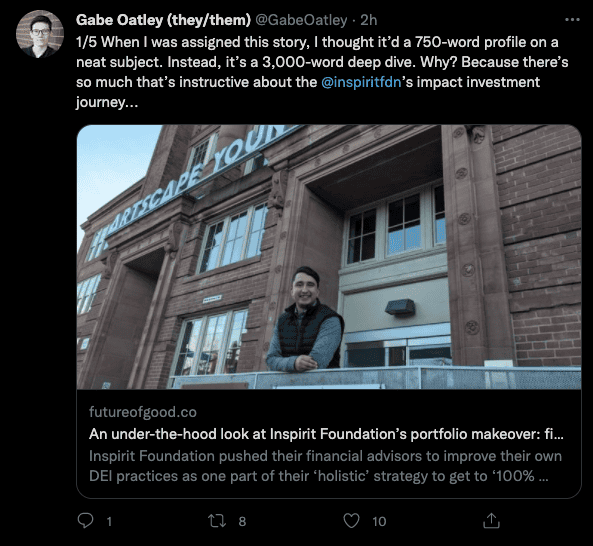
Inspirit’s Six-Year Impact Portfolio Makeover
Read the in-depth feature on our journey to a 100% impact portfolio. Board Chair Mitchell Anderson and Jory Cohen, Director of Finance and Impact Investment, share the strategy and the practical steps in this Future of Good story by Gabe Oatley.
Read about our impact portfolio makeover here.
An excerpt from the article:
In 2014 and 2015, the foundation made its first impact investments in several socially and environmentally-focused funds. Dollars flowed to the Community Forward Fund, which provides loans to Canadian non-profits and charities; to Renewal, which invests in sustainability-obsessed consumer product and environmental technology companies; and to InvestEco, which invests in sustainable food companies like MamaEarth Organics, and Organic Meadow.
The investments weren’t huge. By the end of 2015, the foundation had about $1.5 million (4 percent of their total portfolio) invested in these sorts of high-impact ‘private market’ impact investments — but they were mighty, and helped to demonstrate to the board what was possible, whetting their appetite for more.
In October 2015, they hired [Jory] Cohen, who had been running the Youth Social Innovation Capital Fund, an impact lender that Inspirit had been scoping as a potential investee. They also had meetings with several foundations leading the way in impact investing to learn from them. And, crucially, they commissioned a report, analyzing the potential financial returns of a ‘100 percent impact’ portfolio.
“We [learned] that if we invested our asset base for impact we also increased the potential for higher financial returns over the short and long-term,” Cohen says.
In late 2015, the board met and committed to shift to ‘100 percent impact’ — agreeing that 10 percent of their endowment would go toward high-impact private investments (like InvestEco and Renewal) and that they would “apply impact investing tools” to the other 90 percent of their portfolio.
Read the full article here
